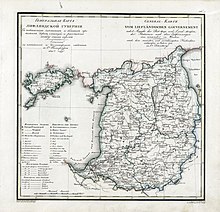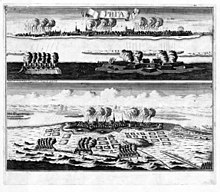Surrender of Livonia and Estonia
Alliance treaties
Preobrazhenskoe (1699) • Dresden (1699) • Narva (1704) • Dresden (1709) • Thorn (1709) • Copenhagen (1709) • Hanover (1710) • Lutsk (1711) • Adrianople (1713) • Schwedt (1713) • Stettin (1715) • Berlin (1715) • Greifswald (1715)
Peace treaties
Traventhal (1700) • Warsaw (1705) • Altranstädt (1706) • Pruth (1711) • Frederiksborg (1720) • Stockholm (1719) • Stockholm (1720) • Nystad (1721) • Stockholm (1729)
Surrenders
The surrender of Livonia and Estonia describes the two treaties of submission between the two Swedish provinces of Swedish Livonia and Swedish Estonia with Tsarist Russia in the Great Northern War .
Contract signing
The rivalry between Sweden and Russia in the struggle for the Baltic region intensified at the end of the 17th century. After the Great Legation through Central and Western Europe, Peter I had decided not to seek the dispute with the Ottoman Empire in the south, but with Sweden in the northwest. In 1700 the Great Northern War began. After almost ten years of fighting and hitherto unknown devastation in the Livonian-Estonian theater of war , the fortunes of war turned permanently in favor of Russia. After the for Karl XII. From Sweden's fateful battle of Poltava in 1709, Russia conquered the Baltic provinces with their capitals Riga and Reval .
Livonia, which was the name of a governorate of the Russian Empire until 1918 and which is now divided between Estonia and Latvia , has been under Swedish rule since 1629. Before the Great Northern War, the so-called reductions had occurred in Swedish Livonia . The traditional Livonian elites should give up their privileges and possessions in favor of the crown. Naturally, this provoked rejection among the estates and the local nobility . In Swedish Estonia, however, the privileges were retained.
Confirmation of the privileges and customs was essential for Swedish Livonia, as Sheremetev issued an announcement in the camp in front of Riga in November 1709 on the power of the tsar, in which the tsar promised to exempt the Livonian knighthood from Swedish servitude and their rights and freedoms and restore habits. This encouraged the besieged city , to which a large part of the nobility had fled, to surrender. On July 4, 1710, the victorious Russians under the leadership of Sheremetev concluded contracts of submission with the city of Riga and the Livonian Knighthood , so-called capitulations , which established the special position of Livonia and Riga in the Russian Empire. On July 14, 1710, the Livonian Knighthood and the Council of States of Riga paid homage to Tsar Peter I.
On September 29, 1710, similar agreements followed in the surrender with the city of Reval and with the Estonian knighthood , issued in the Russian headquarters , which was then southwest of Reval. The document was signed by the two negotiators of the Estonian knighthood: Reinhold von Ungern-Sternberg and Fabian Ernst Stael von Holstein, who had both been knight captains in the previous years . On the Russian side, General Christian Felix Bauer signed the surrender .
Common content of the documents of surrender
The Livonia Surrender was divided into three chapters and was 65 points long. Under Articles 9 to 11, the Duchy of Estonia and the Duchy of Livonia have their respective privileges, which they had under the Swedish crown (before the time of the reduction), confirmed as permanent by Tsar Peter I for himself and his successors.
The privileges of Livonia, especially as self-government, included the following areas: the judiciary, the rural police, the church administration, the school administration, the administration of matters of general welfare, the post office and the municipality and city administration.
In addition to the general administration of a government , called crown authorities, there were also organs of self-government in Livonia called state authorities. While the crown authorities, including the governor or governor , were subordinate to the central Russian authorities and ministries, the state authorities were independent and independent authorities. According to the capitulation, the Lutheran denomination was expressly recognized as the ruling regional church in 1710 . The German business language was retained or introduced in all authorities and institutions. In schools, both district schools and grammar schools, the language of instruction was German .
rating

Sweden had to formally recognize the surrender in the peace of Nystad with Russia in 1721. The constitutional law of Livonia and Estonia rested on these surrenders in the period between 1721 and 1918. Only the period between 1860 and 1905 and from 1910 to 1917 was characterized by an intensified to radical Russification policy, which increasingly narrowed the privileges of knighthood.
It was a declared aim of the tsar and the Russian government to strip the image of a barbaric empire. It was supposed to be replaced by the image of a Christian country that had lagged behind in development because of the isolation imposed from outside, but that Peter I would rise to become a civilized European country. According to Piirimäe, the affirmations of the privileges associated with the capitulations of 1710 are to be understood as a patronizing gesture towards the elites of the Baltic provinces.
With Estonia and Livonia, areas were incorporated into the Russian Empire for the first time which, like Novgorod , had not only been under strong European cultural influence, but which in their political, social and economic structure, in the level of their spiritual and material culture, in their historical development and thus in their value traditions were real Occident . Incorporating these areas into his empire, which was determined by entirely different historical factors, without causing a break in their development, was a new and responsible task for Russia. Peter used them to get loyal professionals for his plans to modernize Russia .
When Catherine took office , relations between Saint Petersburg and the Baltic provinces were robbed of their previous stability. First of all, she confirmed the privileges of 1710. However, in 1764 at the latest, the empress rethought the question of the autonomy of the provinces. The strengthening of Russian absolutism and the idea of seeing the empire as a whole put Baltic autonomy under severe pressure.
literature
- Karsten Brüggemann, Mati Laur, Pärtel Piirimäe (eds.): The Baltic Capitulations of 1710. Context - Effects - Interpretations (= sources and studies on Baltic history; Vol. 23), Böhlau, Cologne / Weimar / Vienna 2014, ISBN 978- 3-412-21009-0 .


